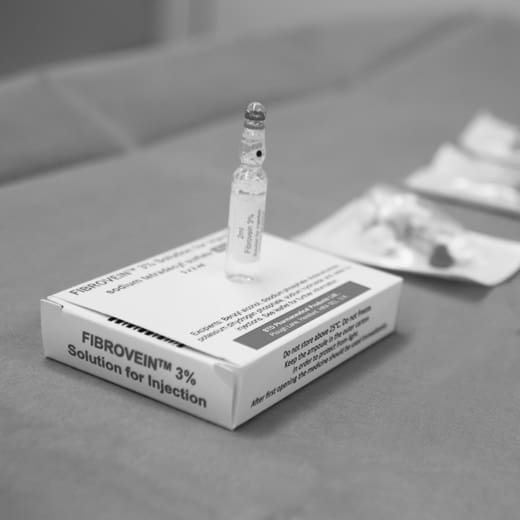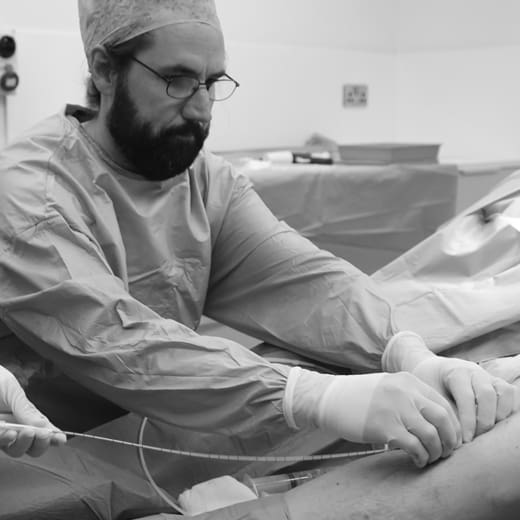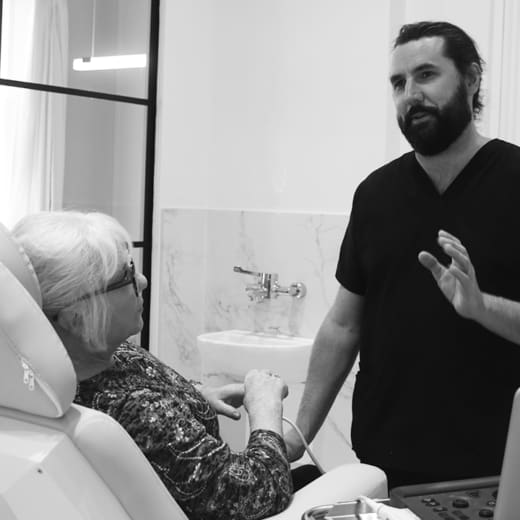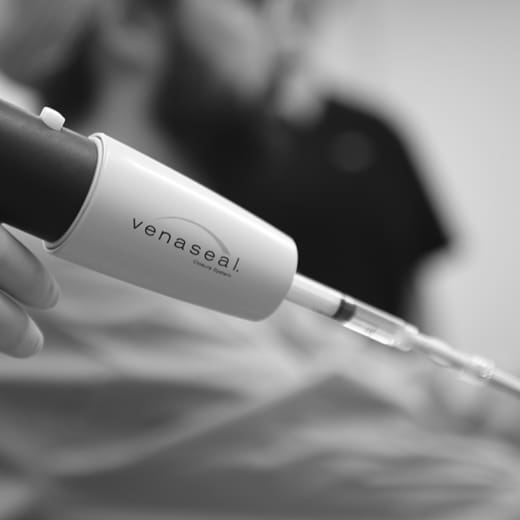McKeown Medical
167 Bath Street, Glasgow, G2 4SQ
Foam sclerotherapy is an advanced form of sclerotherapy used to treat larger varicose veins, particularly those that may not respond well to traditional liquid sclerotherapy.
Date posted — 17.09.24
Foam sclerotherapy is an advanced form of sclerotherapy used to treat larger varicose veins, particularly those that may not respond well to traditional liquid sclerotherapy. In this procedure, a sclerosant solution, which is typically used to irritate and close off veins, is mixed with air to create a foam.
This foam is then injected into the affected varicose vein. The foam displaces blood within the vein, allowing the sclerosant to come into more direct contact with the vein walls, which enhances its effectiveness. The foam’s thicker consistency enables it to stay in the vein longer, providing a more controlled and thorough treatment, particularly for larger or more complex varicose veins.

The benefits of foam sclerotherapy include its minimally invasive nature. It is performed as an outpatient procedure, typically under local anaesthetic, and requires little to no downtime, allowing patients to resume normal activities soon after treatment.
Foam sclerotherapy is also highly customisable; the concentration of the foam and the volume injected can be adjusted to suit the specific needs of the patient, making it a versatile option for treating a variety of varicose veins. While multiple sessions may be necessary to achieve optimal results, foam sclerotherapy is generally well-tolerated and offers a safe and effective alternative to more invasive treatments.
Dr Alex Vesey is our expert consultant vascular surgeon who heads up our varicose vein team. Listen to him explain the foam sclerotherapy treatment.
Foam sclerotherapy is best suited to the smaller veins just below the surface of the skin. Usually, however, varicose veins are caused by diseased vessels deeper in the leg.
Whilst foam sclerotherapy can be used to treat these deeper veins, it is associated with much higher rates of complications, and so to treat the deep veins, we typically perform either Radiofrequency Ablation (RFA) or VenaSeal™ and reserve foam sclerotherapy for the more minor, superficial veins. For the best results, most patients will require a combination of RFA or VenaSeal™ to treat the deep veins with either foam sclerotherapy or microphlebectomy to treat the smaller, more superficial veins.

Foam sclerotherapy involves injecting a specially prepared foam sclerosant directly into the varicose veins to close them off and reduce their appearance and symptoms.
The procedure begins with the preparation of the foam, which is created by mixing a liquid sclerosant with air. Once the foam is ready, it is injected into the targeted vein using a fine needle. The foam fills the vein, displacing the blood and making direct contact with the vein walls. This contact causes irritation and inflammation within the vein, leading to its collapse and eventual absorption by the body.
The procedure is typically performed under local anaesthetic and typically takes around half an hour to perform, depending on the number and size of veins being treated. After the treatment, patients are usually advised to wear compression stockings to help the veins close properly and to aid in the healing process. Most patients can return to their normal activities immediately, though they may need to avoid strenuous exercise for a few days.
The success rate of foam sclerotherapy for treating varicose veins is generally high, with studies showing success rates ranging from 80% to 90%. This means that in the majority of cases, the treated veins successfully close off and are eventually absorbed by the body, leading to a significant reduction in the appearance and symptoms of varicose veins.
However, the success rate can vary depending on factors such as the size and severity of the varicose veins, the patient’s adherence to post-treatment care, such as wearing compression stockings and the patient’s own body’s response to the treatment. While foam sclerotherapy is highly effective, some patients may require multiple sessions to achieve optimal results, and there is a possibility of recurrence over time, which might necessitate additional treatments.

Foam sclerotherapy, while generally safe, can have some potential side effects. Common side effects include mild pain, swelling, and bruising at the injection site, which typically resolves within a few days to weeks. Some patients may experience itchiness or skin discolouration around the treated veins as the body absorbs the collapsed veins. Transient inflammation or redness along the vein path can also occur.
Less common but more serious side effects include deep vein thrombosis (DVT), where a blood clot forms in a deeper vein, which is a rare but significant risk. Allergic reactions to the sclerosant solution, though uncommon, may also occur. In very rare cases, ulceration or hyperpigmentation (darkening of the skin) may develop, particularly in areas where veins were treated. To minimise risks, it is important to follow post-treatment care instructions, such as wearing compression stockings and avoiding prolonged standing or strenuous activities.
Determining if foam sclerotherapy is the right treatment for your condition involves several factors. First, a thorough evaluation by an expert vascular surgeon is essential.
Your surgeon will first ask you questions about your medical history, family history, and lifestyle before performing a physical examination. They will then use an ultrasound scan to identify the anatomy of your veins. It is only with all of this information available that they can recommend the best course of treatment for your particular case. In our practice, we offer the full range of varicose vein treatments – including conservative measures, endovascular treatment with radiofrequency ablation (RFA) or VenaSeal™, as well as – where appropriate – traditional surgery.
Every patient is unique, and our goal is to help match your health needs with the best treatment strategy for your particular condition. The first step is to fill in our online consultation form, and from there, our team will be able to arrange an initial consultation and ultrasound scan, and we can work together to create a treatment plan that is tailored to your needs.

Varicose veins are enlarged, twisted veins that often appear just under the skin, primarily in the legs and feet.

Phlebectomy, or microphlebectomy, is a minimally invasive surgical procedure used to remove varicose veins.

When it comes to treating varicose veins, VenaSeal™ has emerged as a revolutionary option that offers a minimally invasive and...
1 / 3
2 / 3
3 / 3

Varicose veins are enlarged, twisted veins that often appear just under the skin, primarily in the legs and feet.

Phlebectomy, or microphlebectomy, is a minimally invasive surgical procedure used to remove varicose veins.

When it comes to treating varicose veins, VenaSeal™ has emerged as a revolutionary option that offers a minimally invasive and...
Laser rejuvenation of the eye area can be an incredibly powerful tool for the right patients, especially those whose ‘bags’ are more about loose skin and fine lines, like this lovely patient here.
We treated her with full field ablation, which takes around 2 weeks to recover from. Her she is a few weeks later and you can see how much tighter the skin is, the crepey skin has gone and the fine lines have been ironed out. The patient is over the moon.
What do you think?

Eyelid surgery is one of the most popular procedures we do in the clinic. It’s a great fix for hooded eyes! Excess skin on the upper eyelids can not only create a hooded, heavy appearance but often affects the vision too.
Here’s the very talented @bramhallplasticsurgery discussing how upper eyelid surgery (blepharoplasty) can restore a more open, refreshed look by removing the excess skin and subtly redefining the natural eyelid crease. Scars are hidden within the fold of the eyelid, leaving eyes that look brighter, not “done.”
Do you have any questions about surgery? Ask in the comments or send us a message!

Thank you to our patient for allowing us to share her before and after photos of her upper blepharoplasty.
Excess skin on the upper eyelids can make the eyes appear tired or heavy. This simple procedure restores a lighter, more open look while keeping the result completely natural.
Another fabulous result from the very talented @bramhallplasticsurgery!
What do you think?

We’ve been in our new home for a year now and I thought this would be a good time to remind you just how special it is with a little video tour.
It’s been a remarkable year for us in our new home; we’ve introduced new doctors, new treatments, new services and our team continues to grow from strength to strength - always striving to provide more and better for our wonderful patients.
Enjoy the tour!

About last night… It was time once again for our annual Christmas celebration with this absolute bunch of legends. We were a little earlier than usual this year so we could have has many people available as possible, and the evening did not disappoint.
A few sore heads this morning, but absolutely worth it to celebrate the hard work this team dedicate to our patients day in, day out all year round. I am very proud to have the undisputed best team on the planet. Merry Christmas everyone! 🎄

Fine lines etched into the skin around the mouth - this is a common problem and in this patient`s case she had what we call ‘actinic elastosis’, whereby abnormal bands of elastin build up in the skin as a result of years of previous sun exposure.
When patients have this condition, the gold standard way of dealing with it is fully ablative laser resurfacing. It’s an intense treatment with two weeks of downtime afterwards, but the results are spectacular - just like in this lovely patient.
The after photo is three weeks after the treatment and you can see that the skin is still a little pink, which will continue to fade over the next few months.
The patient is already delighted with the result - what do you think?

It’s beginning to look a lot like Christmas!
At least according to Michael Buble, who’s been on repeat in the clinic this week. The decorations are up and we are officially in ‘our season’. The clinic has been packed with everyone having their skin polished in time to make it on the nice list. If you’ve still to make a pre-Christmas appointment, we’ve still got some spaces left for your festive glow up.
Ho ho ho everyone… It’s time for Santa!!!! 🎅🏻

Ok, so this is the one we’ve all been waiting for. Sofwave : the results, in our hands!!!
This is the first patient we treated with @sofwave.uk when we were assessing the machine and deciding whether or not to buy it. These are the patient`s own photos that she kept throughout the healing journey.
Now do you see why we are so excited?! 🤩
#sofwave
#sofwavemed
#SUPERB
#sofwavemedical
#sofwavejourney
#sofwaveexperience

We are now well up and running with @sofwave.uk , much to the excitement of the whole team in the clinic (we are all queuing up to get a shot!)
This is a little video of the treatment being performed, so you can see what the process is like and there is even a little early preview of the results at the end.
One of the best parts is that there is no downtime, so we can still fit it in before Christmas without worrying about redness in the party season!
What do you think?
#sofwave
#sofwavemed
#SUPERB
#sofwavemedical
#sofwavejourney
#sofwaveexperience
